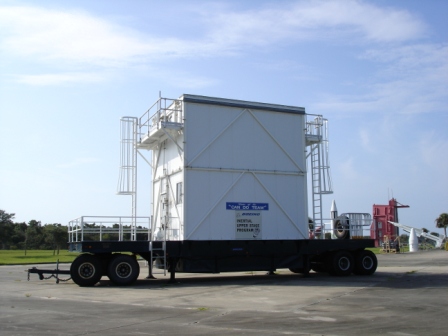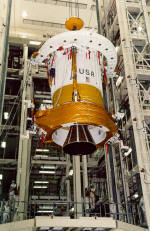
Photo Gallery
Overview
Display location:
IUS (Inertial Upper Stage) Transporter
Type: Transport IUS from processing facilities to launch complex
Agency: U.S. Air Force, NASA
Contractor: The Boeing Company
Cape Canaveral Air Force Station Operations: 1980-2004
History
The Inertial Upper Stage is a two-stage solid-fueled payload booster built by Boeing for NASA and the U.S. Air Force. The key feature of the IUS was its ability to be launched from the Titan III or IV rocket or from the payload bay of the Space Shuttle.
The first use of the IUS was atop a Titan 34D rocket on 30 October 1982. The final use was atop a Titan IV rocket on 14 February 2004. Most of the flights in between were from a space shuttle orbiter cargo bay. Some of the more memorable flights included the Galileo probe to Jupiter on STS-34 in 1989, and the Chandra X-ray Observatory on STS-93 in 1999. An IUS and TDRS payload were aboard STS-51L (Challenger) in 1986.
Uses at the Cape
This transporter/trailer was used at Cape Canaveral Air Force Station and Kennedy Space Center to move Inertial Upper Stages between processing facilities and the launch pad. Inside the transporter is an actual inert Inertial Upper Stage (IUS). The IUS was inserted and removed from the transporter enclosure (the white “box”) by cable hoists at the fixed processing locations. The top (roof) of the enclosure can be lifted off to allow the IUS to be removed.
The transporter was hitched to a semi-truck tractor and towed at very slow speed. The various catwalks and ladders around the outside of the transporter gave technicians access to any part needing attention. An inert IUS is contained within the transporter
The museum reference library contains documents transferred to the museum along with the IUS Transporter on 8 April 2005. A description of those documents and a sampling of photographs is available in the special collections area.
More Payload & Reentry Vehicles